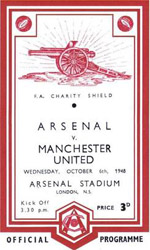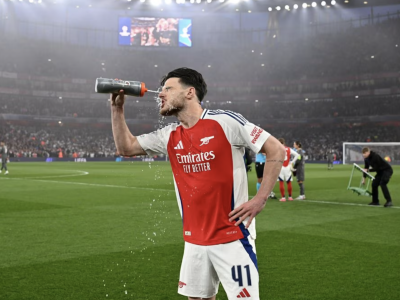Once upon a time, in one of those various online ‘p***ing competitions’ which are very easy to find in cyberspace, I once come across a Manchester United fan who actually included the number of Charity Shields in his club’s all-time trophy count in an attempt to assert Manc superiority over the rest of us. Also, around two years ago, on starting a new role just ahead of the 2013 Community Shield, I got introduced to a Man Utd supporting colleague who, on realising I was an Arsenal supporter started to inform me of exactly how many years it had been since Arsenal last won a trophy. When pointing out that their newly appointed boss David Moyes hadn’t won anything over the same period either, his response was ‘that’ll change on Sunday and you know it!’ – Seemingly secure in the fact that FA Community Shield is an ‘actual’ trophy.
Outside of Man Utd’s rather peculiar fanbase, a few years ago Tony Hodson - the Liverpool supporting editor of the freesheet ‘Sport Magazine’ which is often handed out at various tube and overground rail stations around the capital - bemoaned in an editorial piece that the Charity Shield was not taken as seriously as it used to be in ‘the good old days’ when Keegan scrapped with Bremner, which makes you wonder whether Hodson had actually bothered to do his research on the history of this particular piece of silverware. You see to many people, the Community (nee Charity) Shield is - as is often parroted via the media – ‘the traditional curtain-raiser fixture from Wembley involving the League Champions and the FA Cup winners’. The fact of the matter is however, that actually, it isn’t.
The roots of the FA Charity Shield actually lay in its predecessor trophy – the Sheriff of London Charity Shield – a six foot high shield first competed for in 1898, between who was considered to be the best professional side in England and who was considered to be the best amateur side. Looking at it from twenty first century eyes, this looks like an horrific mismatch on the scale of a heavyweight boxing bout between Vladimir Klitschko and Kenneth Williams, however in the late nineteenth century the term ‘amateur’ sportsman held different connotations and they were mainly drawn from the professional classes in jobs which paid better, and held greater social standing, than that of a professional sportsmen – which naturally they never aspired to become and as such, which led such amateurs to proclaim themselves as ‘gentlemen’ and morally superior to their mostly proletarian professional ‘player’ counterparts.
The first Sheriff of London Charity Shield involved the Corinthian FC – a side founded in 1882 by staunch opponent of professionalism and then Secretary of the FA, Nicholas Lane-Jackson as an English amateur super-club to challenge the supremacy of first the Scots and then the English professionals. Their opponents were Football League champions, Sheffield United. In the 1898 match, the Shield was shared as Sheffield United declined to play extra-time because they disagreed with some of the referee's decisions. The Corinthians went on to appear in nine of the ten Charity Shield games, winning on just two occasions.
The dominance of the professional sides, as well as a rift within the FA over the requirement for all county associations to admit professional clubs - which led to the creation of the breakaway Amateur Football Association - meant that the competition was scrapped in 1908 and replaced by the FA Charity Shield, which was to be the Football League Champions pitted against the Southern League Champions. Again, through twentieth century eyes this looks like another horrific mismatch, however at the start of the twentieth century the Football League was mainly seen as a ‘Northern’ league, with Arsenal the only member side based south of Birmingham and nearly bankrupting themselves in the process due to incurring the cost of frequent travel to the North of England.
The Southern League was at least seen as on a par with the Football League and even, with the initial absence of the maximum wage, seen to have a slight advantage (something you might want to remind a Spurs fan of if they ever claim to be the only ‘non-league’ side to have won the FA Cup in 1901. Southern League sides actually reached the FA Cup Final three years in a row between 1900 and 1902). The Charity Shield however never stuck to a rigid format in its early years and a Professionals v Amateurs theme often reappeared – the 1913 game and four successive games between 1923 and 1926 were actually between a Representative XI of Pros v Amateurs. The settled format of Football League Champions v FA Cup winners wasn’t brought in until 1930, which saw Arsenal actively involved in the fixture throughout the 1930s.
Arsenal’s first Charity Shield game came in 1930 with a 2-1 victory over Sheffield Wednesday (who just twelve months earlier were known simply as ‘The Wednesday’) at Stamford Bridge and retained the trophy twelve months later in a 1-0 victory over West Brom at Villa Park. Arsenal were again back to back winners in 1933 with a 3-0 win over Everton at Goodison Park - and 1934 with a 4-0 win over Man City at Highbury. Arsenal suffered a 1-0 defeat against Sheffield Wednesday at Highbury in 1935, but won the last Charity Shield before the Second World War in 1938, beating Preston North End 2-1 at Highbury.
There were some in the game however that wanted to perpetuate an Amateur v Pro fixture, which led to the reprisal of the Sheriff of London Charity Shield between 1931 and 1934. Arsenal – London’s first professional football side – had by the 1930s become the embodiment of incorporating the Corinthian ideals with the realities of the professional game, with some notable amateurs in the side, such as teacher, journalist and University of London graduate Bernard Joy. You may also recall Arsenal lining up against fictional amateur side The Trojans in the 1930s motion picture The Arsenal Stadium Mystery
The club therefore naturally became involved in two of the three reprised fixtures, however the gap between the professionals and the amateurs was by this point more pronounced with Arsenal winning the 1931 match 5-3 and the 1933 encounter 9-2. The Corinthians however got their own back by beating Arsenal at Golf, as this Pathe News footage showed. The footage also notes that several of the Corinthian golfers were England internationals in the ‘90s (if you don’t recall them lining up alongside Gazza or David Platt, you’re obviously thinking of the wrong century!).
After the Second World War Arsenal were to retain the Charity Shield after it returned from a decade long absence, beating Manchester United 4-3 at Highbury. The Pride of Surrey featured in their first Shield for forty years as Sir Matt Busby’s side’s triumphant 1948 FA Cup Final victory over the Blackpool team of Matthews and Mortensen was their first trophy win for 37 years! Arsenal’s next Charity Shield was to be up against Blackpool in 1953 at Highbury, when the Gunners ran out 3-1 winners. Arsenal did win the FA Cup in 1950, however for some reason the FA chose to pit an England 1950 World Cup XI against an FA Canadian Tour XI at Stamford Bridge, instead of lining Arsenal up against League Champions Portsmouth.
The fixture against Blackpool was to be Arsenal’s last involvement with the FA Charity Shield for the next twenty six years. In the meantime, there was another reprisal of the Sheriff of London Charity Shield involving Arsenal against a descendent of the Corinthian side, Isthmian League side Corinthian Casuals. The contests however were equally as one-sided as they were in the 1930s, with Arsenal beating the amateur side 7-0 in their 1965 encounter and 5-2 a year later.
One thing to note about the importance of these pre-war and early post-war FA Charity Shield fixtures however is that none of them took place at Wembley, they were contested in October rather than as the first fixture of the season in August and, as pointed out in my article on friendly fixtures a couple of weeks back, this was a time before floodlit fixtures were permitted and so took place as an afternoon mid-week fixture during, what was for most people, their hours of work.
It’s noticeable also that there is nothing in the way of newsreel footage of any of Arsenal’s Charity Shield games pre-1953 on the Movietone, British Pathe or ITN Source websites. The attendance figures for these fixtures fluctuate between a high of 31,000 for Arsenal’s game against Blackpool in 1953, to a low of just under 11,000 against Manchester City in 1934 – in an era when some of the most attended games at Highbury brought as much as 70,000 on the gate. Also, in the event of a draw, the Shield was shared by the competing sides rather than replayed. As the name states, the proceeds of the fixture were distributed to registered charities and worthy causes such as the building of hospitals in the days before the NHS was created in 1948. There is however no startling evidence that the fixture was seen as one of importance or a measure of greatness, regardless of what the modern day Manchester United fan thinks.
It’s fair to say that the fixture grew in importance over time – it became the ‘traditional’ curtain raiser to the Football season in 1959 and remained so ever since. There are some noteworthy fixtures in the years that followed – such as former Arsenal keeper Pat Jennings scoring against Manchester United while at Tottenham in a 3-3 drew at Old Trafford in 1967 (@06.00). Ironically however, Arsenal were to be indirectly involved in the next major revision of the fixture’s format during the 1970s, as will be elaborated on further in tomorrow’s article.
*Follow me on Twitter@robert_exley







